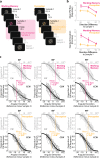Interference between items stored for distinct tasks in visual working memory
- PMID: 36720779
- PMCID: PMC10372107
- DOI: 10.3758/s13414-023-02657-w
Interference between items stored for distinct tasks in visual working memory
Abstract
The action perspective on working memory suggests that memory representations are coded according to their specific temporal and behavioral task demands. This stands in contrast to theories that assume representations are stored in a task-agnostic format within a "common workspace". Here, we tested whether visual items that are memorized for different tasks are stored separately from one another or show evidence of inter-item interference during concurrent maintenance, indicating a common storage. In two experiments, we combined a framing memory task (memorize a motion direction for continuous direction report) with an embedded memory task (memorize a motion direction for a binary direction discrimination) that was placed within the retention period of the framing task. Even though the temporal and action demands were item specific, we observed two types of interference effects between the items: The embedded motion direction was (1) repulsed away and (2) degraded in precision by the motion direction of the item in the framing task. Repulsion and precision degradation increased with item similarity when both items were concurrently held in working memory. In contrast, perceptual and iconic memory control conditions revealed weaker repulsion overall and no interference effect on precision during the stimulus processing stages prior to working memory consolidation. Thus, additional inter-item interference arose uniquely within working memory. Together, our results present evidence that items that are stored for distinct tasks to be performed at distinct points in time, reside in a common workspace in working memory.
Keywords: Perception and action; Visual working memory.
© 2023. The Author(s).
Figures


Similar articles
-
Neural dynamics of reselecting visual and motor contents in working memory after external interference.J Neurosci. 2025 Mar 17;45(18):e2347242025. doi: 10.1523/JNEUROSCI.2347-24.2025. Online ahead of print. J Neurosci. 2025. PMID: 40097181 Free PMC article.
-
Set size effects on working memory precision are not due to an averaging of slots.Atten Percept Psychophys. 2020 Aug;82(6):2937-2949. doi: 10.3758/s13414-019-01902-5. Atten Percept Psychophys. 2020. PMID: 32350828 Free PMC article.
-
Visual objects interact differently during encoding and memory maintenance.Atten Percept Psychophys. 2020 Jun;82(3):1241-1257. doi: 10.3758/s13414-019-01861-x. Atten Percept Psychophys. 2020. PMID: 31512114
-
Measuring memory is harder than you think: How to avoid problematic measurement practices in memory research.Psychon Bull Rev. 2023 Apr;30(2):421-449. doi: 10.3758/s13423-022-02179-w. Epub 2022 Oct 19. Psychon Bull Rev. 2023. PMID: 36260270 Free PMC article. Review.
-
The Short-Term Retention of Depth.Vision (Basel). 2021 Dec 8;5(4):59. doi: 10.3390/vision5040059. Vision (Basel). 2021. PMID: 34941654 Free PMC article. Review.
Cited by
-
All identical objects reduce memory load at the late maintenance stage in working memory.Sci Rep. 2025 May 14;15(1):16700. doi: 10.1038/s41598-025-00433-4. Sci Rep. 2025. PMID: 40369027 Free PMC article.
-
Multifaceted consequences of visual distraction during natural behaviour.Commun Psychol. 2024;2(1):49. doi: 10.1038/s44271-024-00099-0. Epub 2024 May 27. Commun Psychol. 2024. PMID: 38812582 Free PMC article.
References
-
- Allport A. Selection for action: Some behavioral and neurophysiological considerations of attention and action. Perspectives on Perception and Action. 1987;15:395–419.
-
- Awh E, Barton B, Vogel EK. Visual working memory represents a fixed number of items regardless of complexity. Psychological Science. 2007;18(7):622–628. - PubMed
-
- Becker MW, Pashler H, Anstis SM. The role of iconic memory in change-detection tasks. Perception. 2000;29(3):273–286. - PubMed
MeSH terms
LinkOut - more resources
Full Text Sources
Medical

